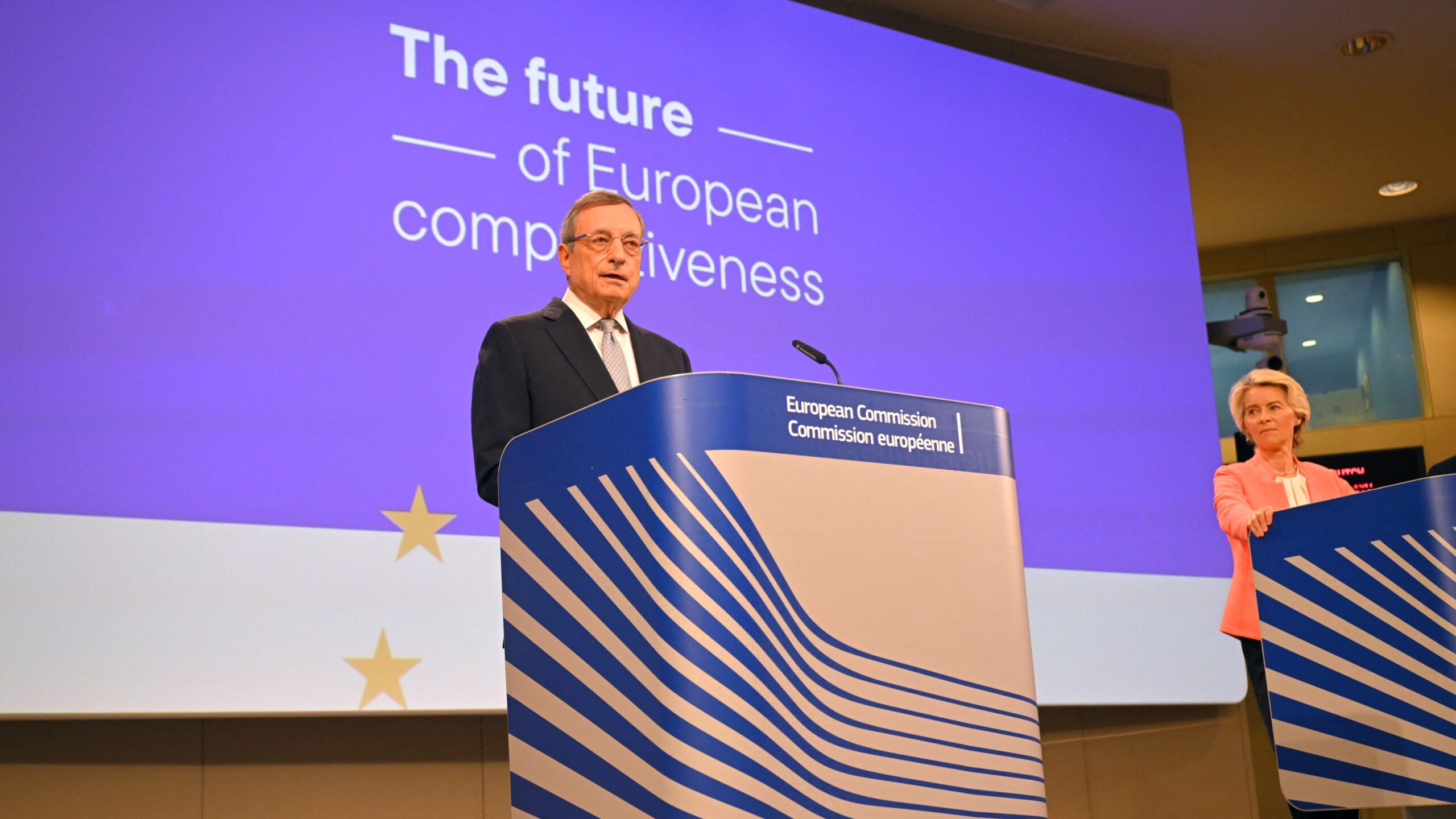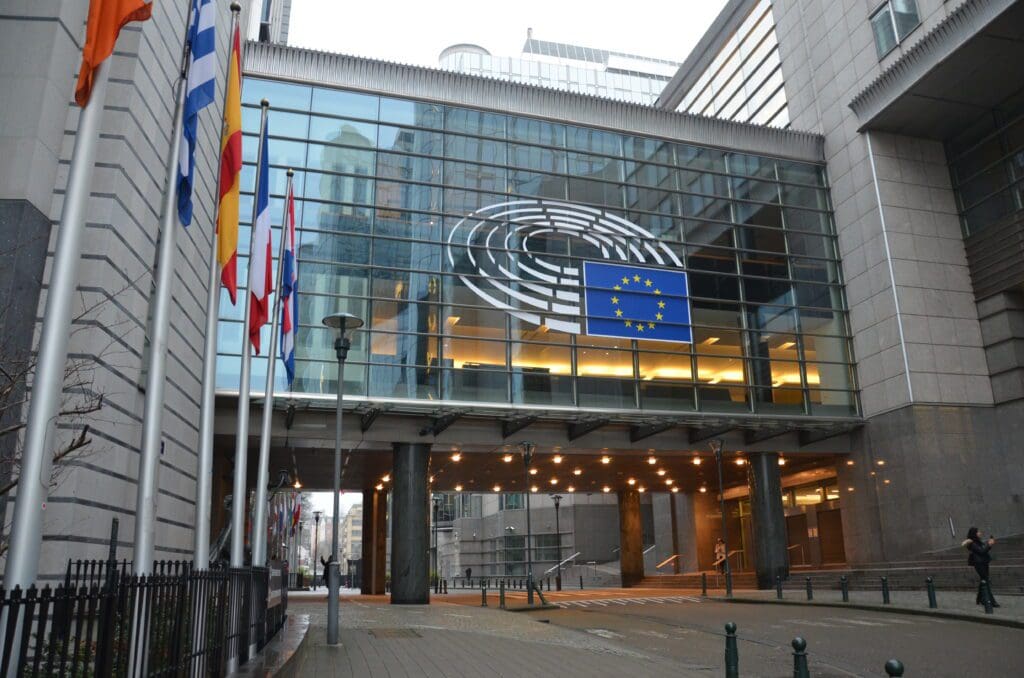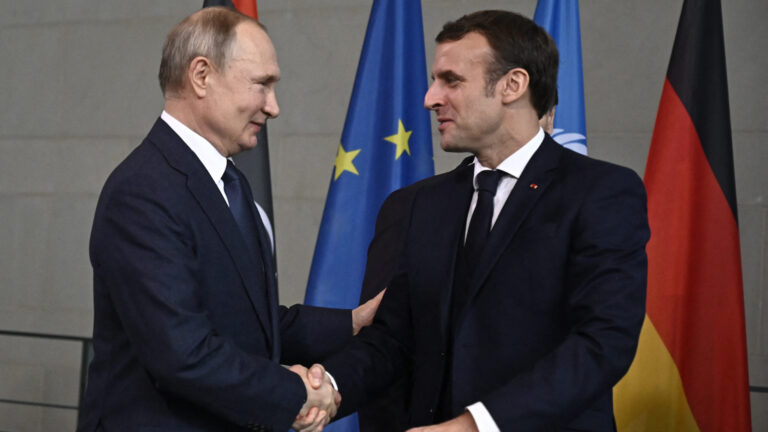As Hungarian Conservative previously reported, Mario Draghi has sounded the alarm bells with his report concerning European competitiveness at the request of the European Commission and Ursula von der Leyen. This is good news, one might say, because at last the European political leadership has realized that we are bleeding from many wounds and that our common European cause is not going in the right direction. In Part I of our in-depth analysis of the report we look at what Draghi proposes and what the issues with his proposals are.
The around 400-page document, published in two parts, was drafted to help save European industry and promote or rethink its competitiveness. The report, titled ‘The Future of European Competitiveness’, calls for immediate action. ‘We have reached the point where, without action, we will have to either compromise our welfare, our environment or our freedom,’ warns the former President of the European Central Bank.
Draghi states that the EU urgently needs to increase its productivity to achieve its political and economic goals. Without significant progress, Europe risks falling further behind global competitors such as the US and China in a ‘slow agony’, especially in the technology sector.
The report first addresses the issue of energy, or rather the energy crisis, which is currently one of the main obstacles to the development of European industry. It also highlights the importance of a well-coordinated transition to climate neutrality. By well-coordinated, we must understand that decarbonization must be carried out in stages, while maintaining the rate of growth of industry, since, with the technology we have at our disposal, a sudden transition would be both impracticable and would result in the total destruction of European industry[1]. No wonder, therefore, that the specifics of how the changeover should be carried out are not detailed at all in the report.
Draghi argues for changes to competition rules that will make it easier for some technology and defence deals to get EU approval, and by calling for investment in technological innovation and clean energy, he sets out a path that he believes will secure Europe’s future on the global stage.
The document is not without dramatic claims: ‘If Europe cannot become more productive, we will be forced to choose. We will not be able to become, at once, a leader in new technologies, a beacon of climate responsibility and an independent player on the world stage. We will not be able to finance our social model. We will have to scale back some, if not all, of our ambitions.’[2] Draghi sees the strategic programme as addressing an ‘existential challenge’, with nothing less at stake than the survival of the European Union.
But what is Draghi’s proposed solution to this ‘existential challenge’? Nothing but 800 billion euros per year in capital injections into the economy over the next five years. It is mentioned in more than one place[3] that this is several times the amount of the previous Marshall Plan (and if it is a Marshall Plan, are we at war?).
‘Draghi sees the strategic programme as addressing an ‘existential challenge’, with nothing less at stake than the survival of the European Union’
To raise the money, among many other measures (such as channelling private savings into the markets, stimulating entrepreneurship, public investment, etc.), a common pan-European borrowing is of course envisaged. It is important to stress that the amount needed to implement the planned measures is such that it cannot be raised without a joint loan. So European borrowing is not the recommended category in the report, but the necessary one. However, there is no complete agreement on borrowing, not only among the Member States, but not even at the level of the EU leadership[4], but even more so on reforming the EU budget, in which resources are supposed to be redirected from Europe’s poorer regions towards industrial, digitalization and innovation policies.
But an even greater price that would be paid if Draghi’s recommendation are followed is the erosion of nation-state sovereignty and the reinforcement of federal centralization at EU level. Draghi is clearly in favour of a strong federal Europe, i.e. he believes that certain areas (e.g. defence procurement, foreign policy, industrial policy, etc.) should be brought under closer centralised control, thereby reducing the powers and autonomy of member states. In his view, only a coordinated, centralized leadership can provide a way out of the current crisis. Among other things, he also calls for the abolition of the veto and the change to qualified majority voting, which he hopes will speed up decision-making. In other words, the solution is more Union and less nation-states.
In sum, the report reflects the political views and values of the EU elite and can be seen as a tool to turn a problem into a crisis—an ‘existential challenge’—to justify the extension of EU powers at the expense of national sovereignty and decision-making[5].
But let’s look at exactly what the report suggests. It identifies three main areas where changes should be made.
The first is accelerating innovation and finding and putting in place new engines of growth. The biggest challenge here is the decline in demand, especially from the Chinese side, and the ever-increasing competitive pressure from Chinese firms.
The second area is energy. Europe needs to bring down high energy prices while continuing the decarbonization process and moving towards a sustainable materials management, or ‘circular economy’. EU companies currently have access to electricity at two–three times the price paid in the US and natural gas at four to five times the price. According to Draghi, decarbonization, the switch to low-cost, clean and secure energy sources, could be the solution for Europe.[6]
Thirdly, Europe must respond to a less geopolitically stable and changing world, where dependencies (energy, strategic raw materials, microchips, etc.) are becoming vulnerabilities. This is equally true for the defence sector. ‘The safety of the US security umbrella freed up defence budgets to spend on other priorities.’[7] But the changing global paradigm no longer allows Europe to rely on others for its own security. So, creating security and developing the defence sector comprehensively is vital for the future.
Draghi argues that decades of globalization have created a high level of ‘strategic interdependence’ between major economies, making any rapid separation almost impossible or expensive. ‘For example, while the EU largely depends on China for critical minerals, China depends on the EU to absorb its industrial overcapacity. But this global equilibrium is shifting: all major economies are actively seeking to reduce their dependency and increase their scope for independent action[8].’[9]
The EU must also respond to the dramatically changed security environment at its borders, Draghi acknowledges. The EU’s total defence spending is currently one third of US levels, while the European defence industry suffers from decades of underfunding and depleted stocks. ‘To achieve genuine strategic independence and increase its global geopolitical influence, Europe needs a plan to manage these dependencies and strengthen defence investment,’[10] the report states.
The need for a plan and the need for immediate action is beyond dispute! But it is worth asking a few questions about the how.
‘Competitiveness’
It is legitimate to ask why this concept is central to the analysis. The answer could stem from a philosophical point of view: the economy has become a kind of destiny in our time, and has become the primary factor in human existence, superseding all other components, including religion, morality or transcendence. We cannot discuss this is detail here. But the fact remains that without a strong economy, it is impossible to play on the international stage.
Competitiveness has become a catch-all term in EU jargon to describe Europe’s problems. Basically, it reflects the fear that Europe is lagging or being left behind. It is beyond dispute that European productivity and growth lag behind those of the US and China. Europe has few companies at the top of the global technology industry (four out of the top 50 market leaders to be precise) and relies too heavily on older industrial companies for research and innovation. It also pays more for energy, finds it harder to attract investment and merely regulates what others innovate.
Without growth and competitiveness, it will become increasingly difficult for Europe to finance its social programmes and to provide its citizens with the quality of life they have always enjoyed, not least because one of its fundamental values has always been identified with it.
The Causes of the Decline
The report attempts to identify the causes of the EU’s declining competitiveness. In this context, it reveals both well-known and lesser-known factors to explain the lag. Despite the many achievements of the single market, the persistent fragmentation in the technology, finance, and defence sectors means that the EU cannot compete with American and Chinese giants. This has created a negative feedback loop between tech and finance, in which high-potential start-ups leave the EU for Silicon Valley as they seek larger investments and partnerships with the big players among tech firms. These problems have been known for some time. Mario Draghi’s report focuses on the lack of innovation, shedding new light on the aforementioned problems. He would like to see ‘risk-takers’ better rewarded with government support and even private financing. In the latter case, the EU should, in his view, channel household savings more effectively into productive investments.
I’m still at loss about how the EU would persuade people to invest their savings right away. Can this really be the foundation of a long-term strategy? Draghi suggests that the most efficient way to mobilize savings is to overhaul the long-term savings system, namely, the pension system. To be precise, the EU should encourage individuals to invest in private pension funds to boost capital market flows. Needless to say, this is a highly controversial proposal for some countries, such as France or Hungary for example.
In fact, mobilizing savings and boosting the entrepreneurial spirit among the population is not merely a technical issue. At this point, we encounter a significant obstacle rooted in cultural differences. Europe’s productivity problems stem not only from trade challenges or overregulation, but also from deeper, culturally embedded differences that reveal that the EU, unlike other regions such as the US and China, approaches risk, labour, and economic incentives in a different way. The EU prioritizes protecting workers, ensuring work-life balance, and maintaining a social safety net, often at the expense of peak productivity. This is reflected in labour regulations, such as the mandatory closure of retail stores on Sundays, which is almost unimaginable in the US, where laws favour employers, and businesses maximize their opening hours.
‘Draghi suggests that the most efficient way to mobilize savings is to overhaul the long-term savings system, namely, the pension system’
In the EU risk aversion is deeply rooted in culture, and there is a general distrust of debt, whether personal or business, which hinders entrepreneurship and market dynamism. The report aims to change this attitude, with the US model in mind. The US culture accepts, and even considers normal personal loans and risk-taking, creating an environment where access to capital and consumption are strongly supported, which encourages market opportunities and innovation.[11]
I believe that the truth lies somewhere in between these two views. On the one hand, slavishly copying a North American economic, let alone social model, is unviable within the Union. It simply cannot be transplanted into European conditions, not least because of the aforementioned cultural differences. Moreover, let’s not forget that the United States, which we have used as an example, is currently grappling with the most severe debt crisis in its history. This year’s US budget deficit is 1.5 trillion dollars, and the total public debt has already reached 35 trillion dollars, which is more than the total national wealth of the United States. The US is fortunate enough to have the world’s primary and only reserve currency for now. However, the moment a real challenger emerges in this area, the US economy is at risk of collapse.[12] Therefore, it is not surprising that the European population is wary of borrowing for this reason as well.
On the other hand, it is also true that there is a need for more entrepreneurship and risk-taking than at present. While the EU model is excellent at providing for the well-being of citizens, it also makes them comfortable, resulting in a significant gap in peak productivity and maximizing disposable income. This situation highlights the difficulties of reconciling social goals with economic optimization. For a successful business, social responsibility, environmental goals or the promotion of social justice are more of a hindrance than a stimulus. Decision-making on the latter is a matter for democratically elected leaders, not for corporate actors.
Restructuring Geopolitical Directions and Reducing Dependencies
The drive for competitiveness is as much a geopolitical issue as it is a political one. Commission President Ursula von der Leyen made this a central theme in her bid for a second term.[13] She pledged in her speech to the European Parliament in July that competitiveness would be her top priority (and some of Draghi’s recommendations have already been incorporated into the political programme for the next five years). This is undoubtedly part of von der Leyen and her allies’ efforts to distance themselves from the stereotypical image of the EU as a massive, impenetrable rulebook that makes doing business impossible. A Europe that cannot compete economically, cannot mitigate risks, cannot build secure supply chains, and is dangerously exposed to price shocks from energy suppliers or partners needed for the green transition will not be a major player on the world stage.
Although the report does address the European defence industry, Europe’s strategic autonomy or the management of increased external security risks, it does not propose new solutions but takes the current direction of the European Commission as the right starting point (sanctions policy, strong transatlantic ties, unconditioned support for Ukraine, etc.). In fact, it proposes to intensify these efforts and to take them to the next level. Nevertheless, it stresses: ‘Peace is the first and foremost objective for Europe. But physical security threats are rising and we must prepare.’[14] It is a fact that the EU ranks second in the world overall in terms of military spending—neck and neck with China, which spent $296 billion last year[15], roughly the same as the EU countries’ combined spending—but this is not at all reflected in its strength and the capabilities of its defence industry.
The report highlights Europe’s vulnerabilities in terms of critical raw materials (CRMs) and technological dependencies. Global demand for minerals such as lithium, cobalt and nickel has increased significantly due to the clean energy transition, but their supply is concentrated in a few countries, particularly China. This creates two main risks: price volatility and geopolitical tensions. Price volatility makes investment decisions more difficult; for example, lithium prices have risen twelvefold in two years and then fallen by more than 80 per cent, preventing the opening of competitive mines in the EU. Moreover, as China has a significant share in the processing of critical minerals, it risks using them as a geopolitical weapon, as we have already seen with export restrictions.[16]
Europe is at a disadvantage compared to other global powers such as the US and China because it does not have a comprehensive strategy to secure its critical raw materials supply chain. The EU does not have a coordinated approach like other countries, where government programmes support mining, processing and recycling. China, for example, is actively investing in foreign mining projects in Africa and Latin America through its Belt and Road Initiative, while the United States provides significant financial support for building domestic processing and recycling capacity through legislation such as the Inflation Reduction Act (IRA).
The EU’s technological dependencies are also significant, particularly in semiconductors, where Europe relies almost entirely on foreign countries[17]: the US, South Korea and Taiwan dominate semiconductor manufacturing, while Europe’s own capacities in this area are extremely limited. The EU does not have a sufficiently developed infrastructure for state-of-the-art chip production and is therefore dependent on Asian manufacturers. There is also a strong dependence on artificial intelligence hardware and cloud services, mainly from US companies.
The report recommends that the EU accelerate the implementation of the Critical Raw Materials Act (CRMA)[18] and develop a comprehensive strategy covering all stages of the raw materials supply chain, from mining to recycling. It also suggests that the EU establish a Critical Raw Materials Platform, allowing EU countries to engage in joint purchasing and coordinated stockpiling, similarly to the South Korean and Japanese models.
Furthermore, according to Draghi the EU should intensify its ‘raw materials diplomacy,’ for example by creating a G7+ Critical Raw Materials Club, which could include other strategically aligned countries such as Japan, South Korea, and Australia[19]. Additionally, the EU should expedite the opening of domestic mines, especially for critical raw materials like lithium, of which Portugal has significant reserves. Moreover, a greater emphasis should be placed on recycling, as it is estimated that the EU could meet more than half of its metal demand for clean technologies through domestic recycling by 2050.
What needs to be added here is that the EU’s challenges related to critical raw materials and technological dependencies are closely linked to the Union’s geopolitical shift. In recent years, the EU has increasingly recognized that its dependence on foreign supply chains and technological infrastructure poses a significant geopolitical risk, especially in relation to countries with strategically different orientations, such as China. In response, the EU is trying to develop a new geopolitical strategy that reduces external dependencies, mitigates its vulnerability in terms of critical raw materials and technological supply chains, makes it more resilient to geopolitical pressure, and increases the Union’s autonomy in the global environment. However, for the EU to remain a competitive player on the global stage, it is essential to create lasting security and an effective defence industry. In the next part of this article, we will examine the topic of security.
[1]Even according to the Draghi report, fossil fuels will continue to dominate in the field industry until 2030. The feasibility of a full decarbonization process is beyond the scope of this article. I will just make a brief addition. To meet the decarbonization timetable, Europe will need to produce 50GW of additional energy from nuclear by 2050 (currently around 97GW from 103 plants). This will require the construction of at least 30 new reactors over 20 years, or between €5-11 billion per gigawatt to produce 50 GW of nuclear capacity! The total investment budget is estimated at between €650-750 billion. And we have only touched on the nuclear aspect of the switchover.
[2]Mario Draghi, ’The future of European competitiveness. Part A. A competitiveness strategy for Europe’ (September 2024), European Commission, p. 1, https://commission.europa.eu/document/download/97e481fd-2dc3-412d-be4c-f152a8232961_en?filename=The%20future%20of%20European%20competitiveness%20_%20A%20competitiveness%20strategy%20for%20Europe.pdf, accessed 25 Sept. 2024.
[3]Theo Legett, Laura Gozzi, ’EU facing existential risk without investment’ (9 Sept. 2024), BBC.com, https://www.bbc.com/news/articles/c4gq1e7k2j8o, accessed 9 Sept. 2024; The Editorial Board, ‘The Guardian’s view on Europe’s future: spend big or risk the consequences’ (17 Sept. 2024), The Guardian, https://www.theguardian.com/commentisfree/2024/sep/17/the-guardian-view-on-europes-future-spend-big-or-risk-the-consequences, accessed 18 Sept. 2024.
[4] See Giovanna Faggionato, Hans von der Burchard, ’Germany’s Lindner rejects Draghi’s common borrowing proposal’ (9 September 2024), Politico, https://www.politico.eu/article/germanys-lindner-rejects-draghis-common-borrowing-proposal/, accessed 10 Sept. 2024; Thomas Moller-Nielsen, ’Draghi report splits German goverment, receives pushback from Netherlands (9 September 2024), Euractiv, https://www.euractiv.com/section/economy-jobs/news/draghi-report-splits-german-government-receives-pushback-from-netherlands/, accessed 10 Sept. 2024; Nicolas Rolander, ’Swedish pm says Draghi report falls into common debt trap’ (16 September 2024), Bloomberg, https://www.bloomberg.com/news/articles/2024-09-16/swedish-pm-says-draghi-report-falls-into-common-debt-trap, accesed 20 Sept. 2024.
[5] MCC Brussels, Phil Mullan’s lecture titled ‘The Draghi Report reflects the values of the EU elite’ (26 September 2024), MCC Brussels/YouTube, https://www.youtube.com/watch?v=_ZfImkqLZHI
[6] As I have already pointed out, the viability of the ambition and the viability of a zero-carbon or decarbonization process is a very complex and controversial issue that would require a separate article.
[7] Draghi report (Part A), p.1
[8] Mary E. Lovely, Jing Yan, ’While the US and China decouple, the EU and China deepen trade dependencies (27 August 2024), Peterson Institute for International Economics, https://www.piie.com/blogs/realtime-economics/2024/while-us-and-china-decouple-eu-and-china-deepen-trade-dependencies,accessed 10 Sept. 2024.
[9] Draghi report (Part A), p. 11
[10] Draghi report (Part A), p.11.
[11] Jonathan D. Rhyne, ’Mario Draghi’s new report on EU competitiveness didn’t mince words’ (10 September 2024), Medium, https://medium.com/@jdrhyne/mario-draghis-new-report-on-eu-competitiveness-didn-t-mince-words-54da8bf68b09, accessed 12 Sept. 2024.
[12] Brandon J. Wichert, ‘America’s Greatest Enemy Isn’t China or Russia: It’s $35 Trillion In Debt’ (4 June 2024), The National Interest, https://nationalinterest.org/feature/americas-greatest-enemy-isnt-china-or-russia-its-35-trillion-debt-210525, accessed 6 Sept. 2024.
[13] Ursula von der Leyen, Statement at the European Parliament Plenary by President Ursula von der Leyen, candidate for a second mandate 2024–2029 (18 July 2024), https://neighbourhood-enlargement.ec.europa.eu/news/statement-european-parliament-plenary-president-ursula-von-der-leyen-candidate-second-mandate-2024-2024-07-18_en , accessed 10 Sept. 2024.
[14] Draghi report (Part A), p.3
[15] Nan Tian, Diego Lopes da Silva, Xiao Liang and Lorenzo Scrazzato, ’Trends in world military expenditure, 2023’ (April 2024), SIPRI, https://www.sipri.org/sites/default/files/2024-04/2404_fs_milex_2023.pdf, accessed 10 Sept. 2024.
[16] Jorge Liboreiro, ’China restricts export of two metals that EU condsiders of “strategic” importance’ (4 July 2023), Euronews, https://www.euronews.com/my-europe/2023/07/04/china-restricts-exports-of-two-metals-that-the-eu-considers-of-strategic-importance, accessed 10 Sept. 2024.
[17]Kleinhans, Jan-Peter, The Missing Strategy in Europe’s Chip Ambitions. Interface (30 July 2024) https://www.interface-eu.org/publications/europe-semiconductor-strategy
European Commision, European Chips Act. (21 September 2023) https://commission.europa.eu/strategy-and-policy/priorities-2019-2024/europe-fit-digital-age/european-chips-act_en
[18] The Critical Raw Materials Act (CRMA) is a European Union legislative proposal presented in March 2023 aimed at securing the supply of critical raw materials (CRMs) which are essential for the EU’s economic and industrial resilience.These materials, such as lithium, cobalt, and rare earth elements, are key to green and digital technologies, including batteries, wind turbines, solar panels, and semiconductors. The act reflects the EU’s efforts to reduce its dependence on non-EU suppliers, particularly countries like China, while increasing European raw materials extraction, processing, and recycling capacities.
[19] A G7+ Critical Raw Materials Club would be a forum for cooperation among the G7 countries and other like-minded nations on critical raw materials issues. This could involve sharing best practices, coordinating investments, and developing joint projects.







